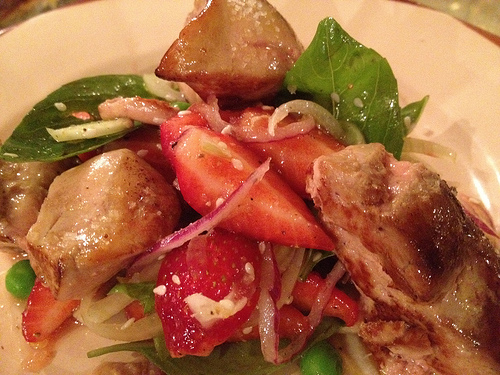 |
| Potato selection is important, I picked what Foodworks called 'Red Potoatoes' |
All told the exercise took about three hours. Most of that it preparing the gnocchi dough. My first problem was that we didn't have a working set of scales. Consulting a bunch of different internet sources I established I'd need about 1.5kg of potatoes (floury ones) and 2 cups of plain flour. In the end I held a kilo of flour in one hand and the potatoes in the other, moving potatoes until they were about the same weight. After boiling them until their skins start to fall off you peel the potatoes. This is traditionally done by hand and turned out to be a very tedious process.
 |
| Wouldn't this be great with a prospective beau? |
In the process you gradually mix in a whisked egg. The aim is to create a dough that's just sticky enough to hold together. Mum helped me with this part, while at the same time telling stories about the Italian families she grew up friends with, who, along with us Irish, used to make up the Catholic community in Reservoir.
While I was waiting for the potatoes to boil I made the pesto. You toast about 1/2 a cup of pine nuts (they cook very quickly, be careful not to burn them!) then blend them with 3 or 4 cloves of raw, chopped garlic and 1 cup of olive oil. Next cut up a large bunch of basil and blend that in to. Remember the aim is not to create a puree, just a very finely chopped mixture. Finally stir in about 1/2 of grated Parmesan cheese. Don't do what I did and add extra cheese, you'll just make it too salty.
Having finally achieved a gnocchi dough you just roll it out and cut into gnoccho-sized pieces. Rolling them on a fork will give the distinct gnocchi shape, but I couldn't be bothered so just rolled little balls. After cooking (I'm sure everyone knows how to cook gnocchi) place them in bowl and mix the pesto though before serving. Unlike most pastas where the sauce goes on top pesto works best in an even covering.
 At the Food Fair my little gnocchi were widely appreciated (maybe those who didn't like it just didn't say anything). I probably won't make them again in the near future (the time! the mess!), though I think gnocchi making would be a great activity to do on a date. The pesto on the other hand is dead easy. I think it's set to become a staple.
At the Food Fair my little gnocchi were widely appreciated (maybe those who didn't like it just didn't say anything). I probably won't make them again in the near future (the time! the mess!), though I think gnocchi making would be a great activity to do on a date. The pesto on the other hand is dead easy. I think it's set to become a staple.







